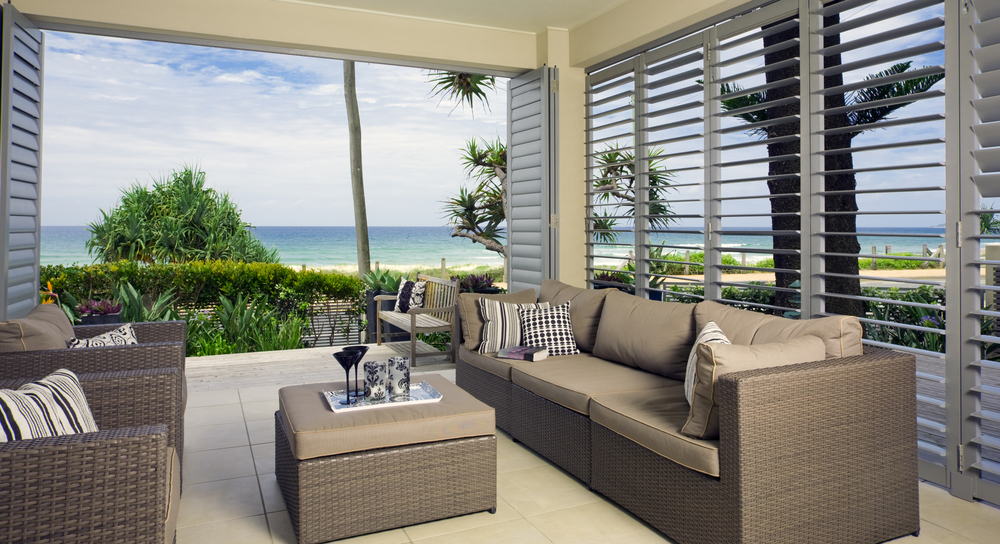When a chance to relax and breathe finally arises, you’re looking for furniture to perfectly complement your hard-earned vacation. You want something elegant, classy; of course, you do, but above all else, your outdoor furniture has got to be comfortable. Now is not the time for uncomfortable, stiff furniture. This time is a chance for you to relax at last, and you want to enjoy every minute of it.
As appealing as it is, comfort is useless, however, if your furniture cannot stand up to the harsh conditions of the beach. While the salty air, hot sun, and rolling waves may be bliss for you, moisture, intense heat, and salt can all severely damage your furniture, which is why it is important to carefully consider the material that your dream set of beach furniture is made of. The trifecta of heat, water, and wind means that unfortunately what should be a breezy purchase requires a bit of planning and investigation
Starting off with a couple to be cautious of, and first up is wood. Speaking broadly, it’s best to avoid wooden beach furniture: wood is hard to clean and extremely susceptible to sunlight, water, wind, and salt damage, as well as being vulnerable to insects. However, there is an exception; teak is an exceptionally seaworthy wood; resisting rain and water damage, sunlight, and even insects, as well as bringing a lovely golden color to your furniture. To keep that color, teak does require consistent maintenance with linseed oil, however, and furthermore, teak furniture is a bit of an expense, as the many qualities it offers means it carries a hefty cost.
Steel or wrought iron furniture is also generally to be avoided. While the unique patterning of wrought iron makes it an attractive and easy to clean option, its weight means it is resistant to being knocked around by the wind, it is susceptible to overheating in sunlight, and more importantly, is very vulnerable to rusting. Rust can be combated with constant sanding and painting maintenance or can be prevented somewhat by expensive powder coating options, but generally, the degree of care required is too great to make steel or iron furniture a great option.
A more preferable metal choice is aluminum. Like wrought iron, aluminum is easy to clean, while also being fairly cheap, rust-resistant, and in general weathering quite well. Slight damage from corrosion and sunlight is possible but can be forestalled by powder coating. Aluminum is lightweight, which means it is easy to carry and rearrange but is also vulnerable to gusts on particularly windy days.
Another extremely cheap option is plastic. Plastic endures wind and water with no problems and can be wiped clean with no problem, but tends to lose its color in the sunlight, as well as warping and cracking in extreme heat. Plastic is also the most lightweight and transportable option, but again, very vulnerable to wind. Marine-grade polymer plastics are a slightly more expensive and even more wear-resistant option, designed specifically for waterside use.
Slightly more expensive, but the most environmentally friendly are HDPE (high-density polyethylene) recycled poly furniture options, which are crack and warp resistant, fade resistant, as well as remaining immune to the effects of moisture and salt. HDPE is also highly customizable, available in a variety of styles and colors. It’s an extremely durable option and is lighter than wrought iron while bringing a bit more stability than lighter plastic and aluminum choices. It’s got a lot to offer, but these perks come with a price tag, and it’s one of the more expensive options.
Ultimately most beach furniture decisions will come down to how much you are willing to invest. Broadly, durable options are available no matter the material, as long as you are willing to pay for powder coating, teak, higher-grade plastics, recycled materials, etc. If you don’t foresee much future use for your beach furniture, an extremely cheap choice like plastic makes a lot of sense, and for the middle of the road consumers aluminum has a lot to offer for its price point, but ultimately so long as you use discretion (and remember some of these hints) it’s hard to go wrong.

